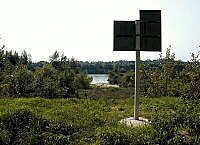 |
| The sign marks the „old“ waterway which is dry now |
At Bratislava, the Danube enters the Hungarian plain where it formerly deposited a big fan of sediments. The Danube runs on top of this gravel and sand body which is filled with one of the largest groundwater reservoirs. This so-called "inland delta” is a very dynamic network of forked and meandering arms that regularly changed its structure. Since 1880, this wild system has been tamed through various river engineering steps that improved navigability and local flood protection.
Dry Danube bed and side-arm system
Modern river engineering was initiated only in September 1977, when a joint
treaty was signed between Czechoslovakia and Hungary to construct the Gabcikovo-Nagymaros
river dam complex. The objectives included improving navigation and flood
protection, and exploiting the river more intensively by producing peak
power at the Gabcikovo Dam, with the resulting flood waves being caught
up in the 130-km-long reservoir impounded by the Nagymaros Dam.
While Czechoslovakia completed most of the scheme in the 1980s, Hungary,
which received support by the Austrian Donaukraftwerke (Danube Powerplant
Co.), started late. In 1989, however, as a result of public protests and
a change in political power, works were halted. Widespread criticism both
inside Hungary and from international experts and environmental groups caused
Hungary to abandon the bilateral treaty in May 1992.
Czechoslovakia, on the other hand, having already invested very much in
the construction, decided in 1991 to quickly build a unilateral solution
in the form of a new river diversion dam at Cunovo, only a few hundred meters
upstream of the Hungarian border. While resumed negotiations encouraged
by the European Commission were under way, Slovak engineers dammed the river
bed in late October 1992 and started operating the power plant. Since then,
over 80% of the river flow and all commercial navigation have been directed
through the 25-km-long Gabcikovo side-canal.
As a result, parts of the Danube bed and the extended side-arm system fell
dry. In spring 1993, artificial irrigation systems started providing water
for these floodplain biotopes on both sides of the river (altogether 8,000
hectares).
 |
| Gabcikovo: one of the hottest water disputes in Europe |
However, the former open and interconnected ecosystem became dissected by numerous dikes and cross-barriers into separated parts. The Danube lost its function as a "life pump” regularly moistening and draining the riparian landscape. The stabilisation of formerly very dynamic hydrological and morphological processes led to a continuous degradation, with many forest areas drying up and fisheries receding and rare pioneer habitats and species diappearing. Another major loss involved the former purification effects for the Danube waters through the filtering process in the rich vegetation and soils.
Are new solutions possible?
In March and April 1997, the legal dispute between the two states was discussed
under world-wide attention at the International Court of Justice in The
Hague. On 25 September 1997, the judges ruled "that both Parties committed
internationally wrongful acts”: They must now negotiate a new solution
jointly using the present technical variant (i.e. without Nagymaros) "in
such a way as to accommodate both the economic operation of the system of
electricity generation and the satisfaction of essential environmental concerns."
Indeed, there are new proposals by Slovak, German and WWF experts to restore
the river-floodplain system.
Since autumn 1997, both parties have conducted a number of negotiations
but have so far failed to find a mutually satisfying solution. Today, Gabcikovo
is a major economic burden since the cost of massive loans and of the dam
maintenance cannot be covered by income generated by the hydropower plant.
Therefore, October 24th was no day to celebrate, neither for the environmentalists
nor for the dam operators.